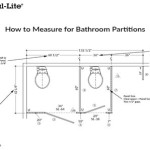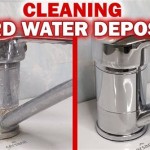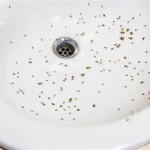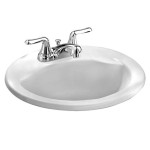How To Remove Stains From Bathroom Vanity
Bathroom vanities are a focal point in any bathroom design, serving both functional and aesthetic purposes. However, constant exposure to water, soap, toothpaste, cosmetics, and other substances can lead to stubborn stains that detract from the vanity's appearance. Knowing how to effectively remove these stains is essential for maintaining a clean and attractive bathroom. This article provides a comprehensive guide to identifying common types of bathroom vanity stains and offering practical methods for their removal.
Identifying Common Bathroom Vanity Stains
Before attempting any stain removal method, it's crucial to identify the type of stain present. Different stains require different approaches and cleaning agents. Some of the most common stains encountered on bathroom vanities include:
Water Stains: These often appear as rings or dull spots, particularly on wood or laminate surfaces. Hard water can leave mineral deposits, creating a white or chalky residue.
Soap Scum: A combination of soap, hard water minerals, and body oils, soap scum typically manifests as a white or gray film. It can be particularly noticeable around the sink and faucet areas.
Toothpaste Splatters: Toothpaste, especially varieties containing dyes, can leave unsightly streaks and spots. If left unaddressed, these splatters can harden and become difficult to remove.
Cosmetic Stains: Makeup, hair dye, nail polish, and other beauty products can cause a range of stains, depending on their composition. Some may be oily, while others may contain pigments that deeply penetrate the vanity's surface.
Rust Stains: Metal objects left on the vanity can cause rust stains, especially if the surface is porous or damaged. These stains often appear as orange or brown discolorations.
Mold and Mildew: In humid environments, mold and mildew can proliferate, causing dark spots and a musty odor. These stains are particularly common in damp areas around the sink and countertop edges.
General Cleaning Practices to Prevent Stains
Implementing regular cleaning practices can significantly reduce the likelihood of stain formation on bathroom vanities. Daily or weekly cleaning routines should be established and followed consistently.
Regular Wiping: Wipe down the vanity surface after each use to remove spills and splatters immediately. This simple step can prevent substances from drying and becoming ingrained in the material.
Proper Ventilation: Ensure adequate ventilation in the bathroom to reduce humidity levels. This helps to prevent the growth of mold and mildew, particularly in damp areas.
Protective Measures: Use trays or mats to protect the vanity surface from potentially staining products, such as cosmetics, hair dye, and nail polish remover. These barriers can prevent direct contact and minimize the risk of stains.
Appropriate Cleaning Products: Use cleaning products specifically designed for the vanity's material. Avoid abrasive cleaners or harsh chemicals that can damage the surface finish. Mild, non-abrasive cleaners are generally the safest option.
Effective Stain Removal Methods
Once a stain has formed, prompt action is necessary to remove it effectively. The following methods offer solutions for various types of bathroom vanity stains:
Removing Water Stains:
For light water stains on wood or laminate surfaces, try wiping the area with a soft cloth dampened with warm water and a mild dish soap. Follow up with a dry cloth to prevent further water damage.
For stubborn water stains, create a paste of baking soda and water. Apply the paste to the stain, let it sit for a few minutes, and then gently scrub with a soft cloth. Rinse with clean water and dry thoroughly.
Using a hair dryer on a low setting can help to evaporate moisture from the wood, preventing further water rings. Ensure the dryer is not held too close to the surface to avoid overheating.
Removing Soap Scum:
A mixture of vinegar and water is an effective solution for dissolving soap scum. Combine equal parts of white vinegar and warm water in a spray bottle. Spray the solution onto the affected area, let it sit for a few minutes, and then scrub with a non-abrasive sponge or cloth. Rinse with clean water and dry.
Baking soda can also be used to remove soap scum. Sprinkle baking soda onto a damp sponge and scrub the affected area gently. Rinse with clean water and dry thoroughly.
Commercial soap scum removers are available, but it's essential to choose a product that is safe for the vanity's surface material. Always test the product in an inconspicuous area before applying it to the entire surface.
Removing Toothpaste Splatters:
For fresh toothpaste splatters, simply wipe them away with a damp cloth. For dried or hardened splatters, soak a cloth in warm water and place it over the stain for a few minutes to soften it. Then, gently scrub the area with a soft cloth or sponge.
A mild all-purpose cleaner can also be used to remove toothpaste splatters. Spray the cleaner onto the affected area, let it sit for a few seconds, and then wipe away with a clean cloth.
If toothpaste stains are particularly stubborn, try using a soft-bristled toothbrush to gently scrub the area. Be careful not to scratch the surface.
Removing Cosmetic Stains:
The method for removing cosmetic stains will depend on the type of product that caused the stain. For makeup stains, try using a makeup remover wipe or a cotton ball soaked in micellar water.
For hair dye stains, act quickly to prevent the dye from setting. Blot the stain with a clean cloth and then apply a mixture of dish soap and hydrogen peroxide. Let it sit for a few minutes and then rinse with clean water.
For nail polish stains, use a non-acetone nail polish remover. Apply the remover to a cotton ball and gently blot the stain. Avoid rubbing the area, as this can spread the stain. Rinse with clean water and dry thoroughly.
Removing Rust Stains:
Lemon juice is an effective natural remedy for removing rust stains. Apply lemon juice to the affected area and let it sit for a few minutes. Then, scrub with a soft cloth or sponge and rinse with clean water.
A paste of baking soda and water can also be used to remove rust stains. Apply the paste to the stain, let it sit for a few minutes, and then scrub with a soft cloth. Rinse with clean water and dry thoroughly.
Commercial rust removers are available, but it's important to choose a product that is safe for the vanity's surface material. Always test the product in an inconspicuous area before applying it to the entire surface.
Removing Mold and Mildew:
A mixture of bleach and water is an effective solution for killing mold and mildew. Combine one part bleach with ten parts water in a spray bottle. Spray the solution onto the affected area, let it sit for a few minutes, and then scrub with a sponge or cloth. Rinse with clean water and dry thoroughly. Note that bleach can discolor some surfaces, so test in an inconspicuous area first and ensure adequate ventilation during use.
White vinegar can also be used to kill mold and mildew. Spray undiluted white vinegar onto the affected area, let it sit for an hour, and then wipe away with a damp cloth. This is a less harsh alternative to bleach.
Ensure the area is properly ventilated to prevent the recurrence of mold and mildew. A dehumidifier can also help to control humidity levels in the bathroom.
Specific Considerations for Vanity Materials:
The appropriate stain removal method will also depend on the material of the bathroom vanity. Different materials require different levels of care and attention.
Wood Vanities: Wood vanities are susceptible to water damage and stains. Avoid using excessive water during cleaning and always dry the surface thoroughly. Use furniture polish or wax to protect the wood from moisture and stains.
Laminate Vanities: Laminate vanities are relatively easy to clean and maintain. Use a mild all-purpose cleaner and a soft cloth. Avoid abrasive cleaners or scouring pads, as these can scratch the surface.
Stone Vanities: Stone vanities, such as marble or granite, require special care. Use a pH-neutral cleaner specifically designed for stone surfaces. Avoid acidic cleaners, such as vinegar or lemon juice, as these can etch the stone. Seal stone vanities regularly to protect them from stains and water damage.
Solid Surface Vanities: Solid surface vanities, such as Corian, are non-porous and resistant to stains. Use a mild all-purpose cleaner and a soft cloth. For stubborn stains, use a non-abrasive scouring pad.

How To Get A Clean Porcelain Sink And Remove Rust Stains Too Mom 4 Real

How Do I Remove This Embedded Stain From Bathroom Sink Hometalk

How To Remove Rust Stains From Toilets Tubs And Sinks

How Can I Remove Hair Dye Stains From A Porcelain Top Vanity Hometalk

How Do I Remove Rust Stains From Cultured Marble Bathroom Sink Hometalk

Pin On Do It Yourself Decor And Improvement Ideas

How To Refinish A Bathroom Vanity Naturally No Vocs Treasured Tips

How Can I Remove Hair Dye Stains From A Porcelain Top Vanity Hometalk

How To Refinish A Bathroom Vanity Bower Power

How Do Wooden Countertops Really Hold Up Exquisitely Unremarkable
Related Posts







